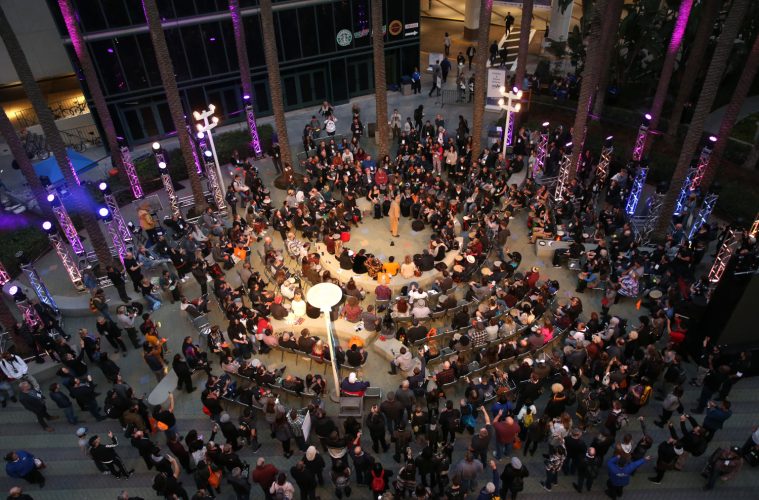By Brian Berk and Amanda Mullen
So much happens at The NAMM Show that it takes not one, but multiple issues to cover it. Whether you attended the January show or not, here were some fantastic events and occasions that you may have missed.

Women@NAMM took a moment during this year’s SWIM meet to honor some of the well-known leaders in the MI industry.
Women Rule the Evening at NAMM’s Annual SWIM Meet
This year’s NAMM Show started with a bang, with Women@NAMM hosting its annual Smart Women in Music (SWIM) Meet on Jan. 15. Each year, this event serves as a networking opportunity for women throughout the industry, enabling them to hear well-known leaders in MI speak about their own experiences and giving them the chance to connect with other women working in music. Among the MI leaders who spoke at the event were DeDe Heid of Heid Music, Robin Walenta of West Music and Crystal Morris of Gator Cases. Each of these women has built a career in the music industry despite obstacles, and through SWIM, they intend to help other women do the same.
The SWIM Fund also offers scholarships every year, through which they provide a stipend for promising young women in the industry to attend The NAMM Show. These women were called onstage during the event to honor their achievements. The five scholarship recipients for this year’s show were Kristi Jacobsen of Alfred Publishing, Alice Monk of Music Industries Association, Heather Mansell of Yamaha Corp., Stacy Swanson of Music & Arts, and Alexandra Bosier of Strait Music Co.
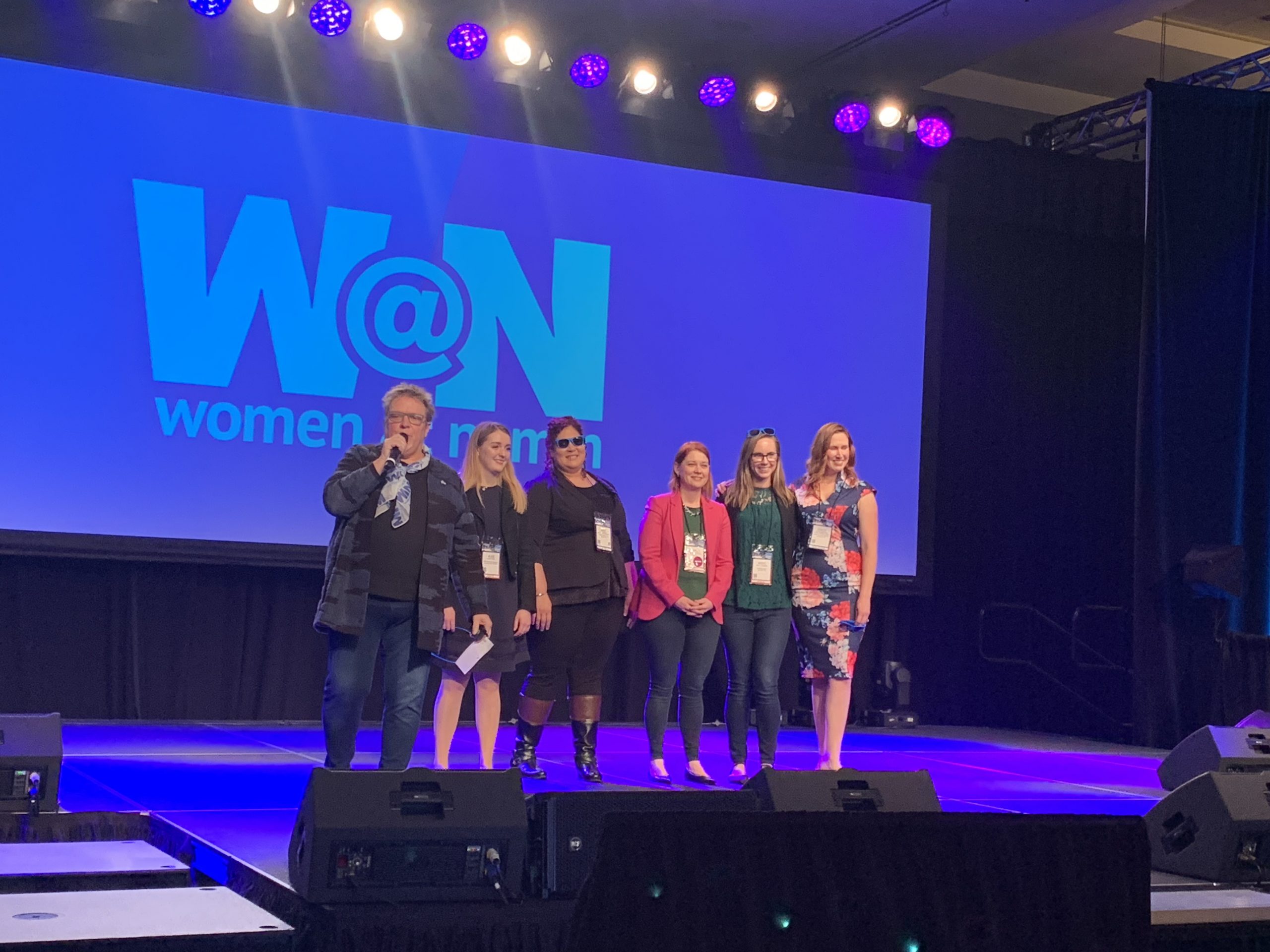
SWIM scholars who were awarded stipends to attend this year’s NAMM Show were called onstage during the SWIM Meet to celebrate their achievements.
SUMMIT scholars were also discussed at this year’s SWIM Meet. The SUMMIT scholars are comprised of 16 women in MI who will have the opportunity to visit NAMM Headquarters during the first week of this month to partake in a two-and-a-half-day leadership emersion experience. These scholars come from music companies including Antonio Violins and Ukuleles, C.F. Martin & Co., Gator Cases, Harman International, KORG, Heid Music, San Diego Music Studio and more.
Overall, the evening was full of moments worth celebrating for women in MI. The message was one of perseverance and hope, and that message will carry on to this year’s Summer NAMM Show, which SWIM is currently accepting scholarship applications for.
PMC Drums Up New Programs for Its 25th Anniversary Celebration
The Percussion Marketing Council (PMC) always offers NAMM Show attendees a membership meeting and percussion industry gathering to remember, but this year the organization drummed up even more excitement with its 25th-anniversary celebration. In addition to providing members with organization updates and networking opportunities, this year’s event also took the time to honor longtime PMC members and introduce new programs the organization is launching in 2020.
Karl Dustman, co-executive director of the PMC, opened the evening with a few words about the organization’s mission. “Twenty-five years ago, we had meetings like this in closets,” Dustman joked, highlighting how far PMC has come in its 25 years of advocacy. Dustman talked about what the night had in store for attendees before introducing Mary Luehrsen of the NAMM Foundation. Luehrsen spoke about “collective impact,” explaining to attendees that “nothing gets done alone.” This theme pervaded the speeches and announcements that followed over the course of the evening, offering a feeling of hope to those in the MI industry, and specifically, those invested in the future of percussion.
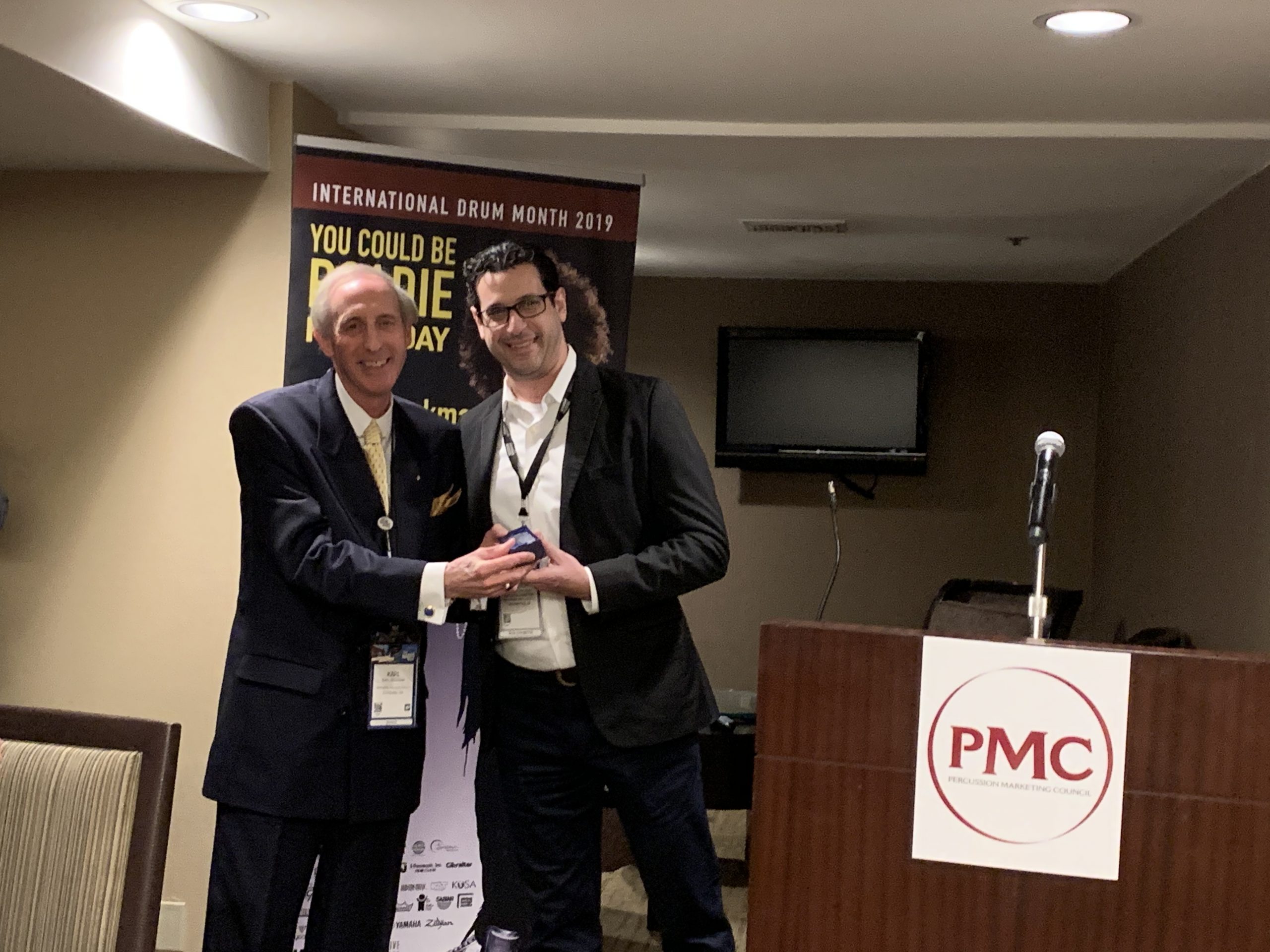
Joshua Simonds, executive director of the Percussive Arts Society (right), honored PMC’s Karl Dustman for his service on the PAS advisory board from 2014 to 2019.
Following Luehrsen’s speech, the PMC went on to honor Hal Leonard’s Brad Smith for his service on PMC’s executive committee. Smith has played a role on the committee for years, and he expressed gratitude for the opportunity, even though he’ll be moving on from that position to provide “special counsel” moving forward. “We are doing important work here at the PMC,” he said.
Dustman himself was also honored for his years of contributions to the Percussive Arts Society, receiving recognition from the advocacy organization’s executive Joshua Simonds. When presenting this honor to Dustman, Simonds emphasized that the drummers and those who support them “are a community” and that they must “stick together.”
PMC also announced two new initiatives at its anniversary celebration, both of which are intended to spread awareness about its mission and increase the number of drummers. The first of these initiatives is “Get Your Sticks Together,” which began in February. With “Get Your Sticks Together,” the PMC will gift 12 drum lessons to a randomly chosen winner during each month of 2020. Retailers participating in this program will be honored at next year’s NAMM Show during the PMC Membership Meeting and Gathering. MI retailers interested in getting involved can learn more about it on PMC’s website, playdrums.com.
“Lessons With a Master” is another program that was announced at the Membership Meeting this year. This contest, which drummers can enter on PMC’s website, will present those participating with an opportunity to win a private, one-hour digital lesson with a famous drummer like Rick Latham, Rich Redmond, David Stanoch or Gorden Campbell.
In honor of PMC’s anniversary, the organization is also holding a contest to win numerous special-edition items, such as snare drums, cymbals and instruction books, all of which feature a 25th-anniversary badge to recognize the occasion. Each of these items was donated by PMC members, and winners will be chosen starting in May for International Drum Month and continuing for the remainder of the year.
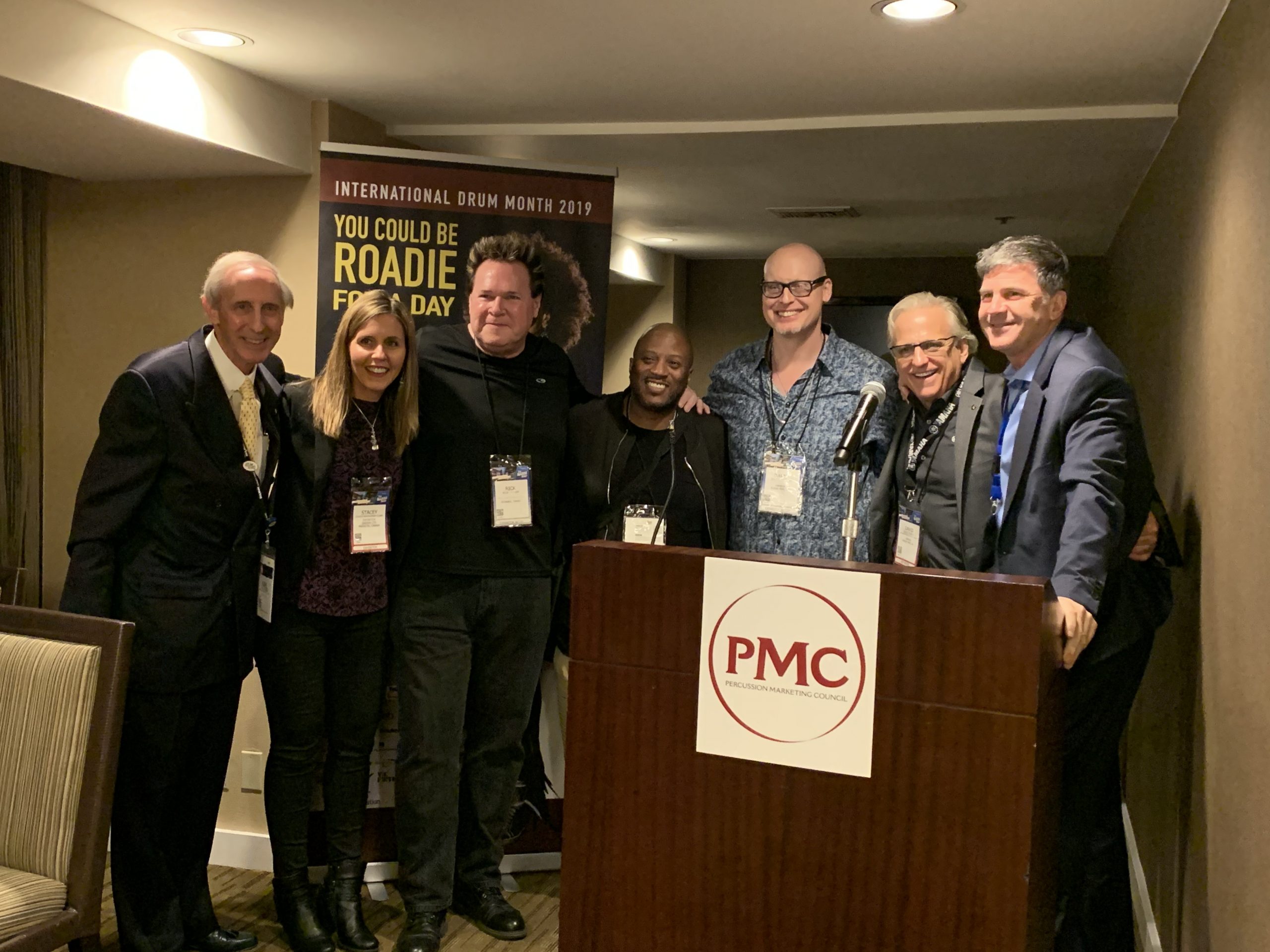
From L-R: Karl Dustman, Stacey Montgomery Clark, Rick Latham, Gorden Campbell, David Stanoch, David Jewell and Brad Smith
Yamaha’s David Jewell, who also serves as an executive officer for PMC, also stepped up to the podium to wrap things up. “Over the past 25 year years, the PMC has connected thousands of wanna-play and existing drummers with the PMC mission and nationwide retailer network through a series of educational programs and free online promotions that have consistently grown in scope, participation and impact throughout the organization’s tenure,” he said. “We are fortunate to have internationally recognized drummers and educators like Gorden Campbell, Rick Latham, Rich Redmond, and David Stanoch helping the PMC promote and create more nationwide awareness for these one-of-a-kind online contests and market development initiatives.
Sennheiser 75th Anniversary Press Conference
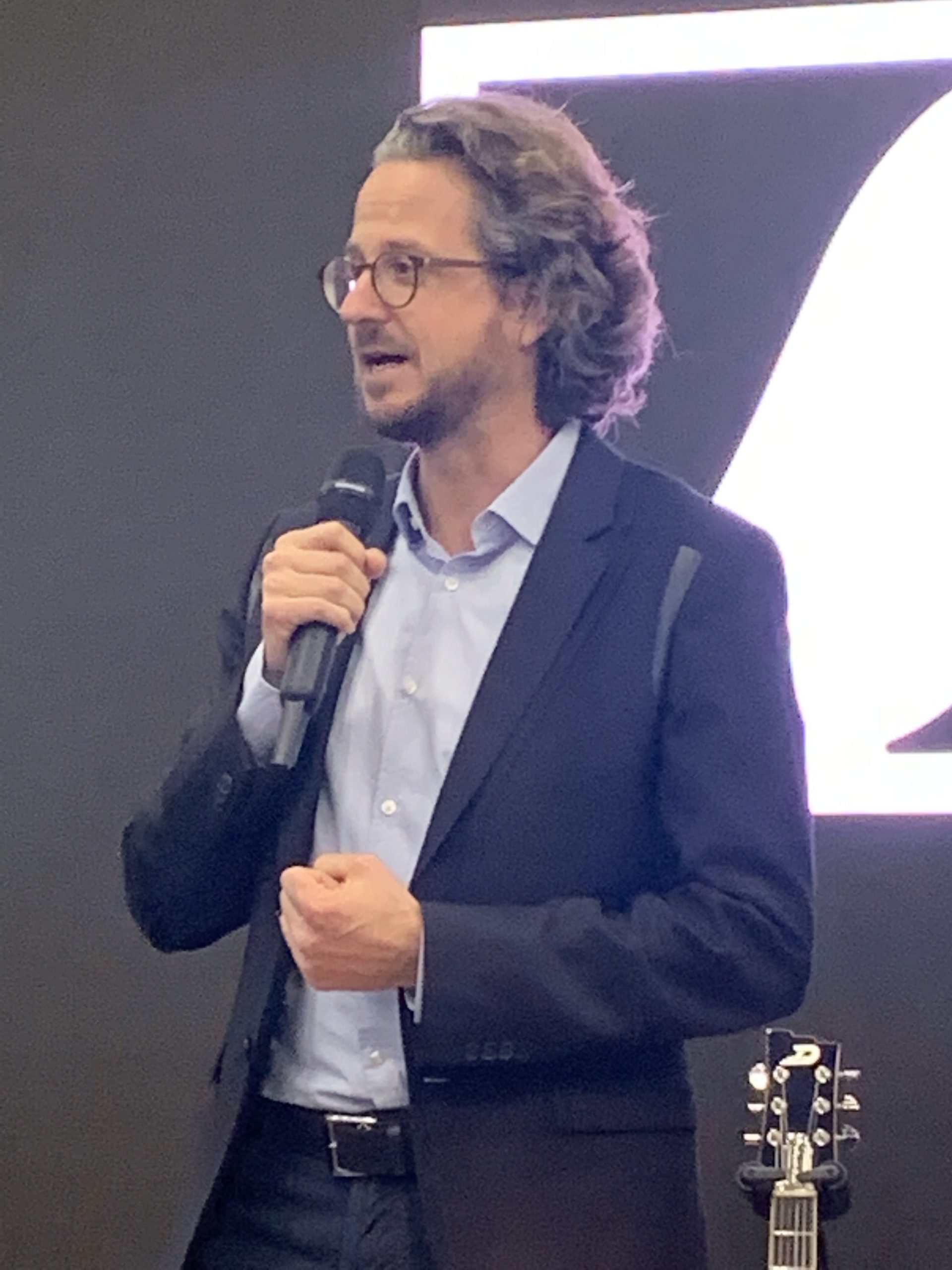
Daniel Sennheiser
“It’s a real honor to be with you to celebrate this 75th anniversary,” said Sennheiser’s Daniel Sennheiser during a Jan. 16 press conference at the company’s booth. “We are here to celebrate 75 years of innovation in the audio industry, and that wouldn’t have happened without all of you. I want to touch on some things that make Sennheiser. First and foremost, it is you, the people who are using our products; it’s the employees who are producing our products; and it is the journalists who are telling our story all around the world.”
Reminiscing on some of the innovations during the past 75 years, Sennheiser noted he was speaking on a wireless microphone. “That was a big achievement from Sennheiser in 1957,” said Daniel Sennheiser. “Since Sennheiser developed the first wireless microphone, we have been continually innovating in that field. We now have a wide variety of wireless microphones.”
Also developed during the past 75 years was the first bodypack transmitter. The company’s “SK 6212 is the smallest digital transmitter in the world and is used on all Broadway shows,” stated Daniel Sennheiser.
In-ear monitoring has been another significant development in the past three-quarters of a century. “We saw a need to deliver better-quality audio for artists on stage,” said Daniel Sennheiser. “At the same time, we have developed the safety of the in-ear monitor so as to not destroy the hearing of the artist.”
Lastly, Daniel Sennheiser discussed the company’s HD 25 headphones. “On the Concorde, the HD 25 was the in-flight headphone,” he recalled. “It was such a good and cool headphone that a lot of customers who were flying on the Concorde ripped out the product that was actually screwed in. DJs went to New York and London to clubs, went to the studio and asked if a new plug could be soldered to it and they used it for their productions. That’s how the HD 25, by accident, became the standard headphone for DJ production. Today on eBay, you can still find some HD 25s with a Concorde logo. They are actually quite expensive. So, part of our success was planned and part of our success was unplanned. That’s how it always happens.”
Kyser Musical Products 40th Anniversary Celebration
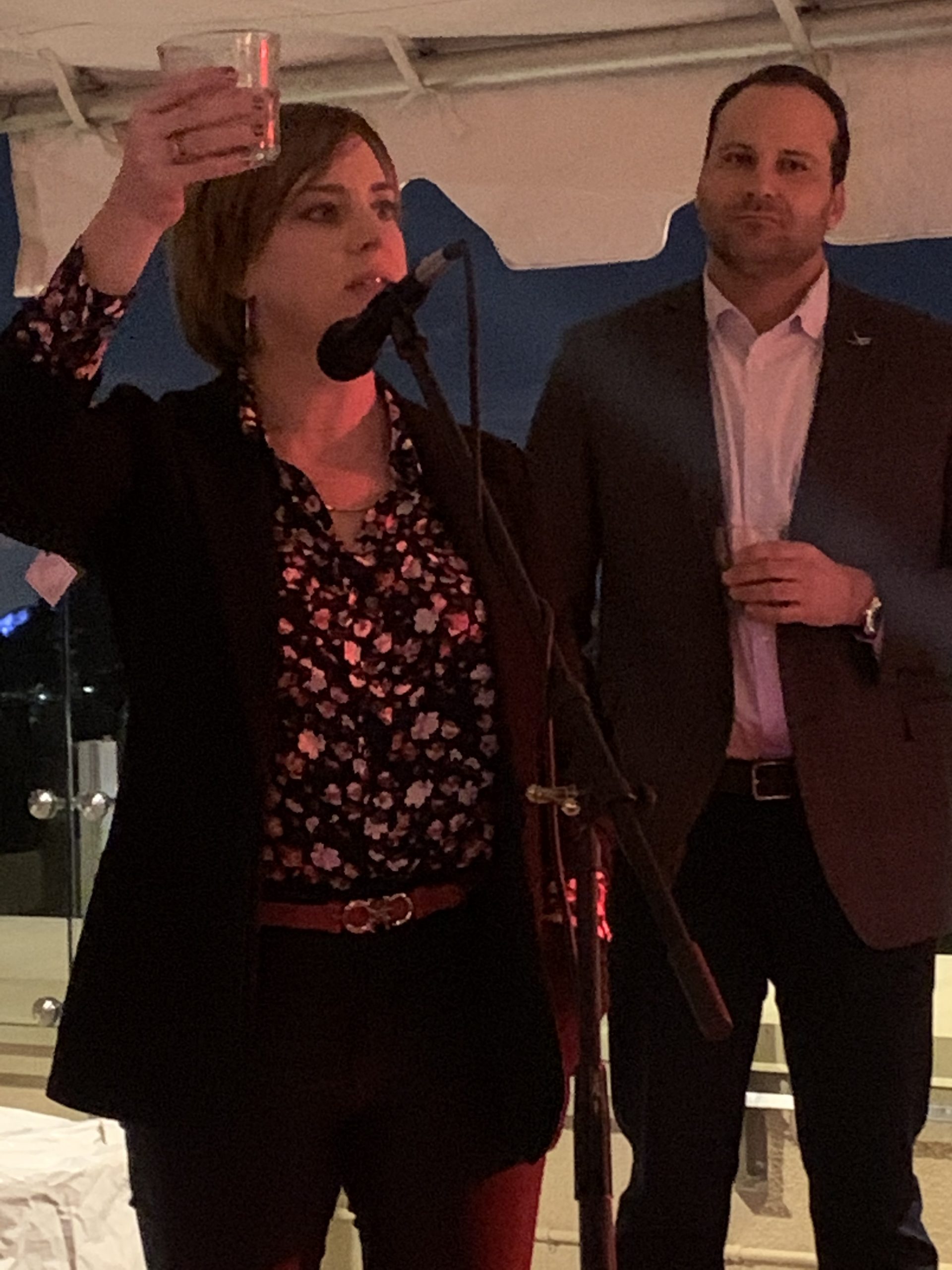
Meredith McClung
Kyser Musical Products celebrated its 40th anniversary on Jan. 16 during a party at The Fifth Restaurant and Bar in Anaheim, Calif.
“We want to celebrate this simple but genius invention of our founder, Milton Kyser, that has withstood the test of time. I would like to thank everybody who has [tried to] come up with a way to outdo it. It is still the same design from 40 years ago that is being used by major artists worldwide,” said Kyser CEO Scott Attebery. “You find it everywhere, from the studio to the junior-high kid learning to play his/her first few chords in his/her bedroom to every club around the world. It’s a signature style for every acoustic and electric guitar player. The power of music is so wonderful, and this little tool helps us to share that with the world.”
“I love that [Kyser] is an international brand, but we all feel like a family,” added Kyser owner and president Meredith McClung. “I want to thank Milton, who passed away in 2014, but because of his clever invention, we are all here tonight. … Did you know Milton only graduated from second grade? And look what he came up with. Let’s raise our glasses to uncle Milton, Kyser Musical, and thank you to all the years of service to our company. To Milton!”
Drum Workshop/Slingerland Press Conference
During its press conference on Jan. 17, after taking a moment of silence to honor legendary drummer Neal Peart, Drum Workshop officially launched the DW Music Foundation. “We have been very charitable for a long time,” said Scott Donnell, vice president of marketing for DW. “We have lots of strategic partners when it comes to donating equipment. This foundation will further that.”
“We are just getting started,” continued Michelle Abrams, executive director of the DW Music Foundation. “We have put structure in place. We have a fun website and social media presence. We have some fantastic initiatives in 2020 for fundraising that includes supporting existing partners we have been working with over the years, including Notes for Notes, the Grammy Museum, In Concert for Cancer, the Alzheimer’s Association, Make-A-Wish Foundation — many great organizations. We recently sent some shakers out to an orphanage in Haiti, where kids had never been exposed to [musicmaking] before. It was very joyful to see what a difference music can make for these kids. We all know the great power music has to unite us, help us heal and bring us joy. Our mission truly is that simple. It is about sharing the gift of music and music-making. We do that in underserved communities of all ages and around the globe.”
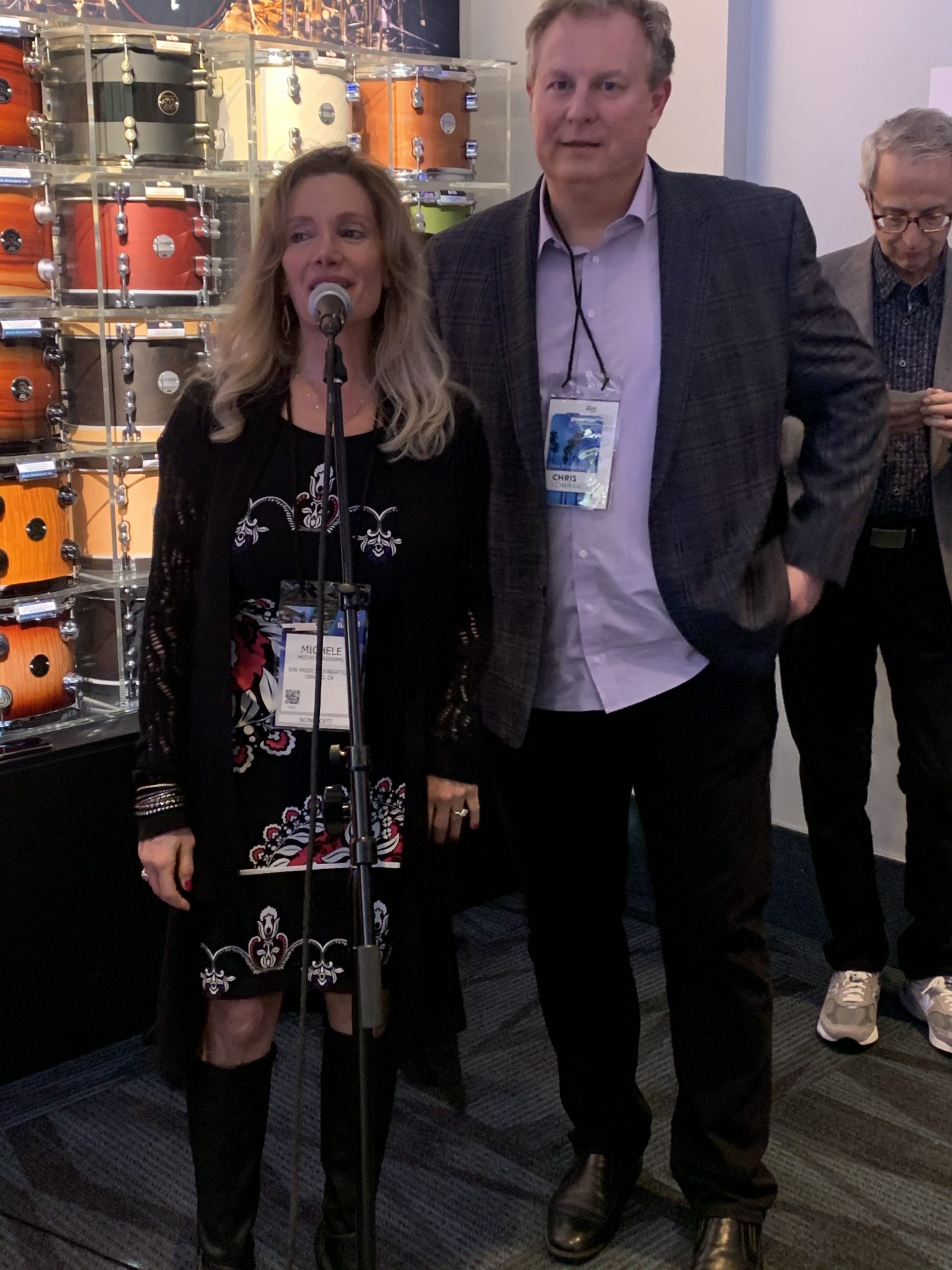
Michelle Abrams and Chris Lombardi
During the press conference, DW also discussed the Slingerland brand that it recently acquired from Gibson. Following a performance by Danny Seraphine, DW founder Don Lombardi referred to the former Chicago drummer’s performance.
“A lot of people have asked what we are going to do with the [Slingerland] brand. I don’t know how you can put it in print, but that’s what we are going to do with it,” he said. “… I was surprised about how many young drummers who didn’t play DW played Slingerland and came to our company from Slingerland. We were talking about giving [previously]. Another way of giving is giving this brand the due it is respected for. I got it as a birthday present, which surprised the heck out of me. Slingerland is the name of somebody, as was Rogers, Ludwig and Gretsch. When the drum set goes out the door, you have your name on it. I have always respected the fact that whenever we have something go outside the door, it has our name on it. We want to take [Slingerland] and give it the honor it is respected and look at the heritage that it brought to all of the music from the day.”
Don Lombardi, who received the gift as a birthday present from his son, DW president and CEO Chris Lombardi, remarked that he talked about the potential of owning the Slingerland name for 10 years.
“It was an honor to be able to do such a special thing for my dad,” said Chris Lombardi. “It is also a testament to just how lucky we are to have each other, in this family business, to be able to pull something like this off. It was not something we needed to get board approvals or go through all sorts of things. It came to us as an opportunity. His birthday was coming, and I thought I could do something to really blow his mind and be really special.” Lombardi then joked, “I don’t know if I will be able to top [the gift]. I definitely set the bar on gift-giving for my kids.”
Regarding the future of Slingerland,“Whatever we do, we want to do it right,” said Chris Lombardi. “We are going to take our time with it. … Part of what we are doing now is learning the brand and just what it meant to everyone. We will honor the tradition of what this great brand was. We are really fortunate to have guys like Danny [Seraphine] to keep us on that path. We are true to what this brand was always about and is about.”
GAMA Breakfast
The Guitar and Accessories Manufacturers Association (GAMA) hosted a Jan. 15 breakfast featuring a panel discussion “Teaching Guitar: What It Means to Me.” Panelists for the session were Adrian Galysh,
the guitar virtuoso, teacher and Yamaha consultant who helped create Guitar Center lesson programs; Martha Masters, president of the Guitar Foundation of America and teacher at Loyola Marymount University and Cal State Fullerton; and Glen McCarthy, teacher at George Mason University and executive director of Teaching Guitar Workshops.
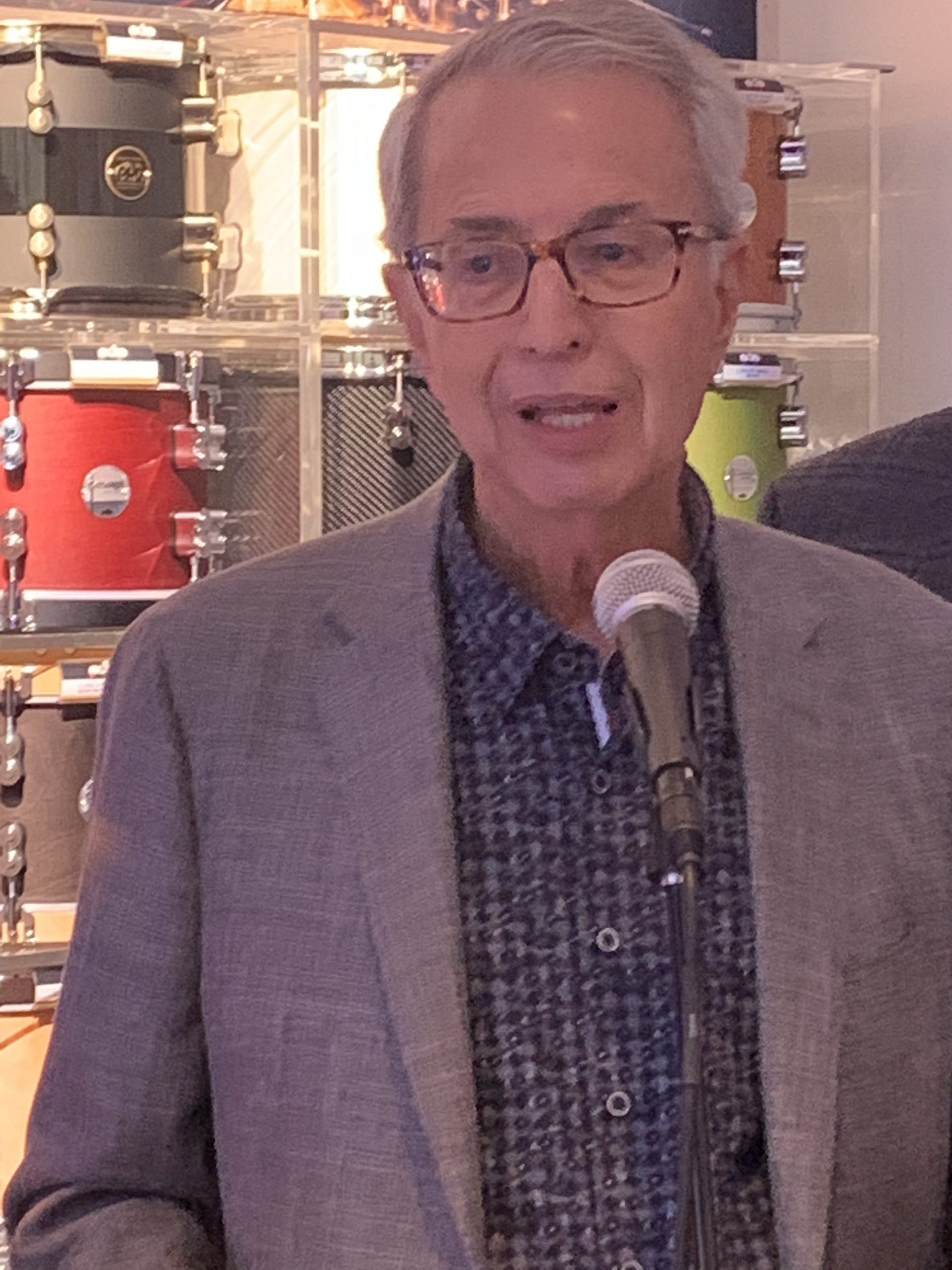
Don Lombardi
Regarding how MI retailers can attract new students for lesson programs, Galysh answered that word of mouth is important. “Anyone who walks in and needs a pack of strings or a guitar for their kid, the next question from the salesperson should be, ‘We offer lessons. Have you thought about having lessons with that guitar you have?’”
As for what drives students into stores to take lessons, Galysh noted it used to be because someone famous was playing the guitar. Today, some students see a person on YouTube perform and want to mimic them. However, more often, Galysh sees students whose parents listen to artists like Ozzy Osbourne, Metallica and Van Halen, and the kids are now listening to them too. “I also hear almost every day that a student went on YouTube and tried to teach themselves, but they learned it is a jungle out there and need a private instructor,” said Gaylsh.
Most of Masters’ students already have secondary-school music experience. “We try at [Loyola Marymount] to support regional high-school music programs,” she said. “We have festivals every spring. Throughout the year, we try to support [high-school] teachers with resources, and curriculum. … We are starting to see more classroom guitar programs that are having a big influence on [students’] lives.”
“What makes a band, choral, orchestral, guitar program strong is not the program, but who is teaching that class,” added McCarthy. “That is what draws students. There is a reputation that gets developed at any school. … I used to have a song of the day at the end of class. The bell would ring and they wouldn’t get up from their seats once it did [though]. The rest of the school was walking by [in the halls] and said, ‘That sounds like a fun thing. I can do that next year.”
A spring trip was another factor that got students interested in McCarthy’s classes. “We would take a spring trip to Nashville, Toronto and Florida. We had the reputation that if you play guitar, you are going to go on the spring trip,” he said. “That’s the kind of thing that will draw kids into the program.”
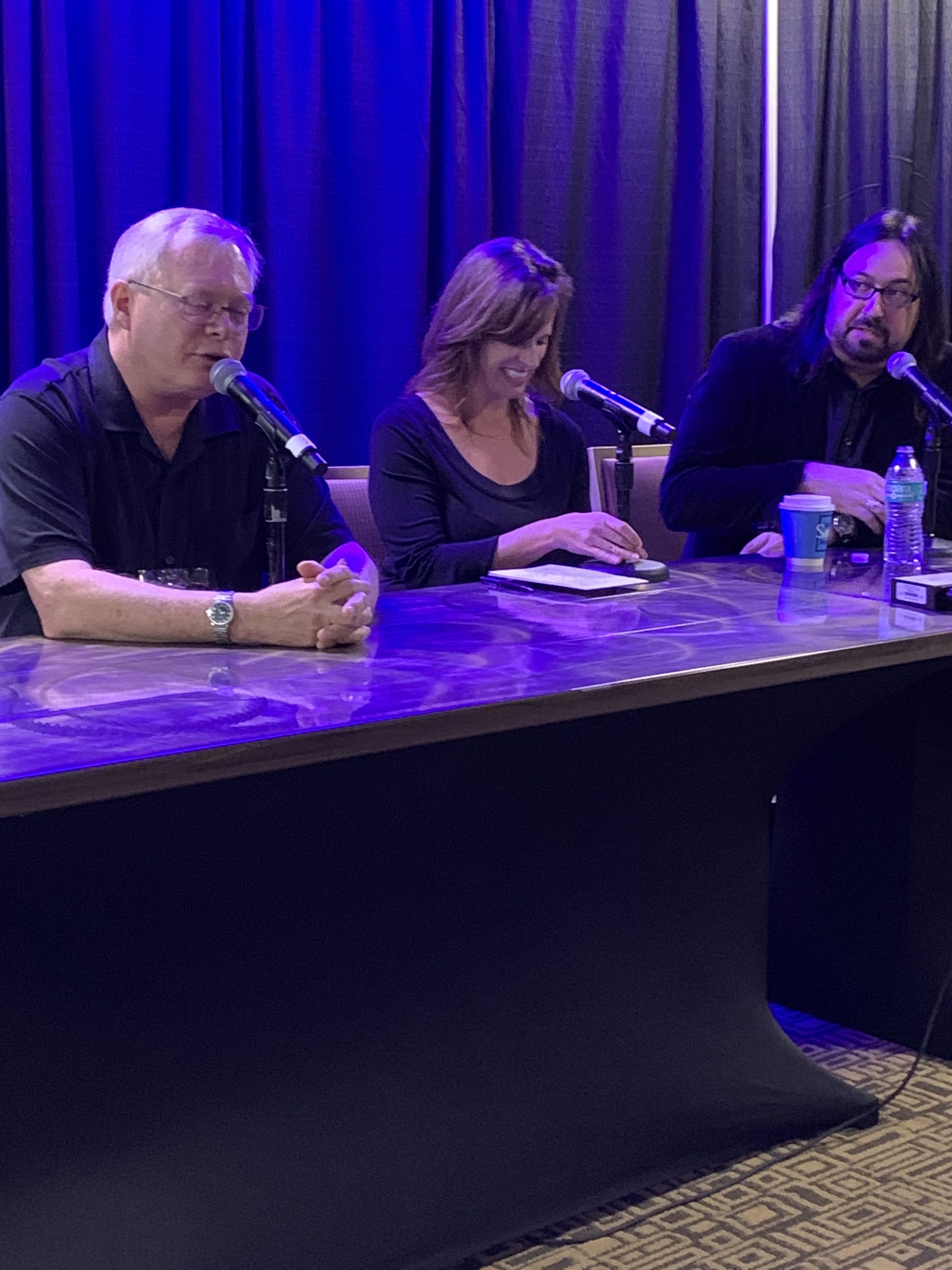
L-R: Glen McCarthy, Martha Masters and Adrian Galysh
Also fascinating was to learn why students quit lesson programs and what can be done about it. “Playing music is hard,” asserted Gaylsh. “If kids are used to winning a video game vs. ‘Oh my God, this is hard and my fingers hurt,’ that’s a whole new experience for them. That affects most kids from 7 to 10 years old. By the time they are 11, 12 or 13, kids are used to a routine and doing homework. They may even have a guitar practice routine. So, there is a bit more commitment.”
Galysh added if a teacher does not have a plan and structure as to how lessons should go for the foreseeable future, students will leave the program. “If the curriculum doesn’t extend beyond the book you grew up with and teach out of, you will be losing students once done with that book. When I teach, I know that the following week, I have material to teach. I know that for the next four years, I have curriculum and books to teach out of. I have selected a path for them. [Students] know that every week they come in [for lessons], there will be new challenges and something fun to do. I once asked a student how their lessons were going [with another teacher]. The teacher asked what they wanted to learn today. The student said to me, ‘Adrian, I don’t know what I want to learn today.’ The teacher should know what I want to learn today. He needs to have a plan in place.”
D’Addario CEO Toast
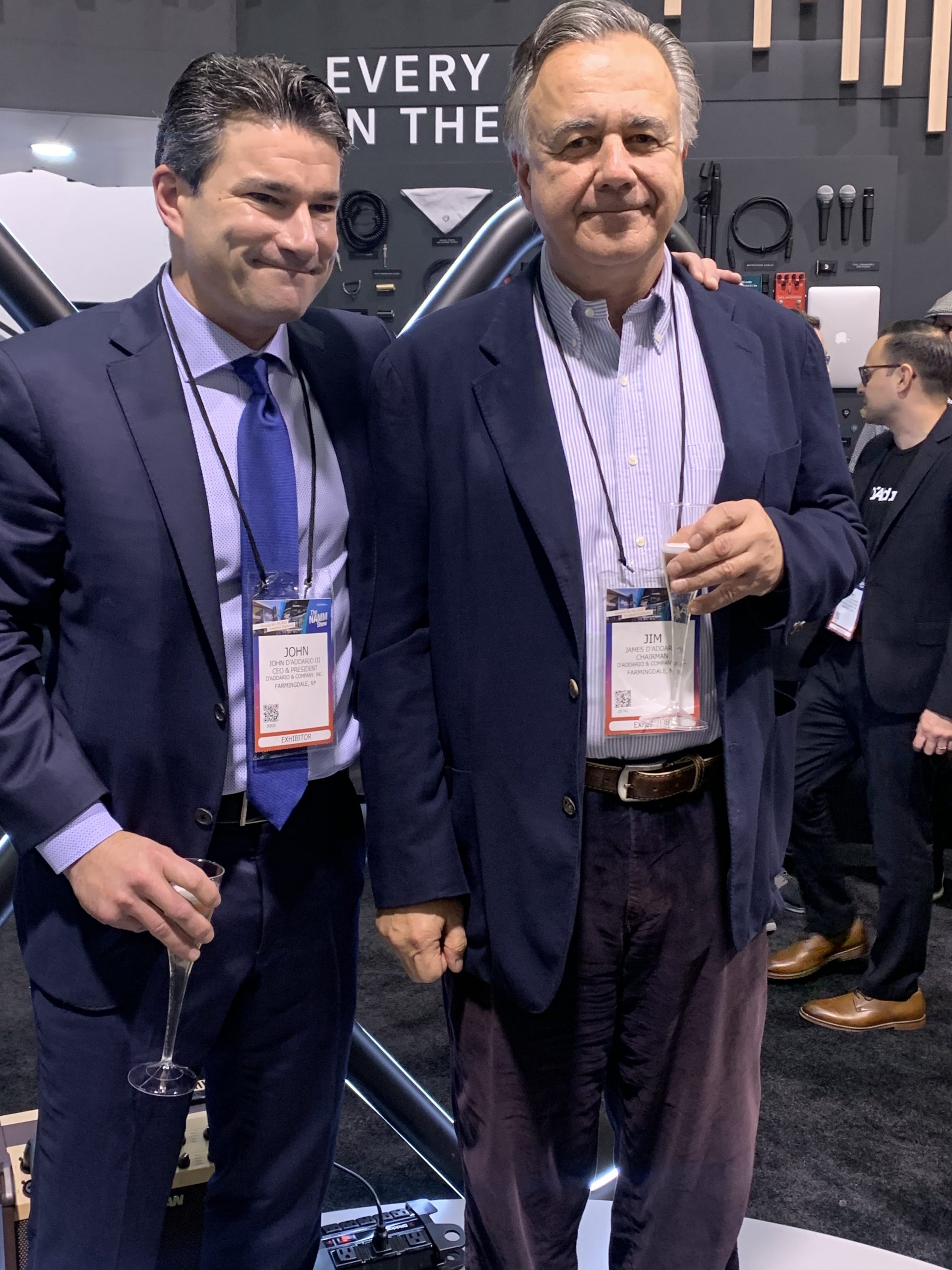
John D’Addario III and Jim D’Addario
D’Addario & Co. hosted a CEO toast at its booth that represented the passing of the CEO torch from Jim D’Addario, who is still quite active in the business, to John D’Addario III. “We’ve had a great fivein the family business,” said Jim D’Addario. “It’sbeen my passion and my love. I can’t say ‘thank you’ enough to everybody. Our families worked hard at succession planning. … I am not going anywhere. I still have a role in innovation and look forward to doing that. We are completely confident John [D’Addario III] is qualified to take the reins. Congratulations John.”
“One of the things Jim and my dad have talked to me about is what a privilege it is to be in a family business and how much of a privilege it is to be in an industry like this,” added John D’Addario III. “We have so many great friends, loyal customers and great competitors. Everyone feels passionate in this industry. I am also very lucky to have worked with my father John, who has taught me so much about business and life. And I am one of the luckiest guys in the industry to work with as brilliant a man as Jim. I will never be like Jim, but I learned a lot from him. One of the great things he has done has built me a great team. We have a phenomenal team at D’Addario. I really look forward to working with them.”
For more on D’Addario’s leadership change, see this month’s “Five Minutes With” on page 32 of our March issue.


